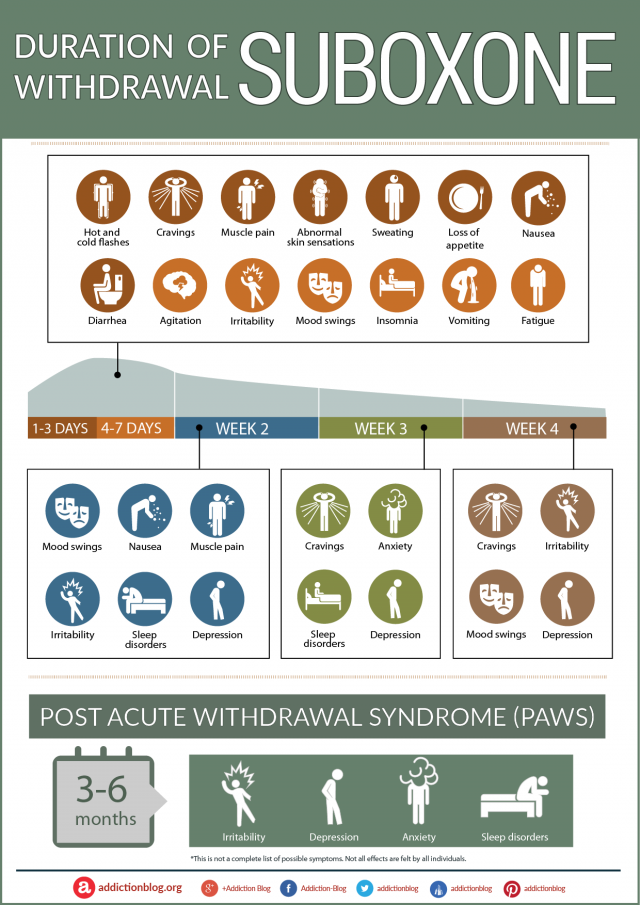Duration Of Withdrawal
Although Suboxone is used to treat opiate addiction, there may come a time when you’re ready to get off it. However, the main ingredient found in Suboxone – buprenorphine – is known to cause physical dependence. So, if you lower the dose or completely stop taking the medication, you may experience withdrawal symptoms.
But, what is Suboxone withdrawal? How can it be treated? Find the answers in our drug withdrawal infographic! We break down symptoms by occurrence and timing..so you can know what to expect. Perfect download for your treatment clinic, office, or detox setting!

And if you find it interesting, feel free to share it! The embed code is right under this visual presentation.
The Detox Timeline
As a combination of two psychoactive ingredients, buprenorphine and naloxone, Suboxone may cause serious withdrawal when reduced or stopped abruptly. In general, the set of symptoms starts when the effect of the last dose has worn off. When does each symptom of Suboxone withdraw occur? Check out this detailed list below to find out:
0-72 hours after the last Suboxone dose:
- Abnormal skin sensations
- Cravings
- Diarrhea
- Hot and cold flashes
- Loss of appetite
- Muscle pain
- Nausea
- Sweating
3-7 days after the last Suboxone dose:
- Agitation
- Insomnia
- Irritability
- Fatigue
- Mood swings
- Vomiting
Week 2 Suboxone Withdrawal:
- Depression
- Irritability
- Mood swings
- Muscle pain
- Nausea
- Sleep disorders
Week 3 Suboxone Withdrawal:
- Anxiety
- Cravings
- Depression
- Sleep disorders
Week 4 Symptoms of Suboxone Withdrawal:
- Cravings
- Depression
- Irritability
- Mood swings
NOTE: The safest way to treat any withdrawal is with medical assistance. When you are supervised in a medical detox setting, you can get physical as well as psychological support. Plus, doctors can prescribe you symptomatic relief when needed.
How Long To Withdraw?
It depends.
Each case of withdrawal is unique and different in terms of length. Moreover, there are many other health factors affect the withdrawal symptoms and their duration.
The main factors that will influence duration of withdrawal from Suboxone include:
- Your general health.
- Your individual metabolism.
- Suboxone dosage and frequency of use.
Still, some withdrawal symptoms can last for several weeks up to few months. In fact, long-term Suboxone users may experience post-acute withdrawal syndrome (PAWS). These symptoms may last for a longer period.
The most common Suboxone PAWS are:
- Anxiety
- Depression
- Irritability
- Sleep disorders
We understand it is difficult to talk to someone about your struggle. Check out our interactive Virtual Consultant to receive your treatment options easily.
Confidential and Free.
Your Questions
Need help for Suboxone withdrawal? How should you treat Suboxone addiction? Give us a call NOW on the number listed on this page to be connected with a compassionate addiction recovery specialist. The helpline is trustful and available 24/7.
Still got questions? Feel free to write them in the comments section at the end. We will try to respond promptly and personally.








Related Posts